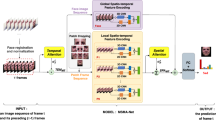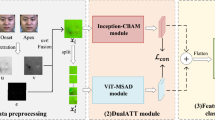Abstract
Micro-expression (ME) is required in real-world applications for understanding true human feeling. The preliminary step of ME analysis, ME spotting, is highly challenging for human experts because MEs induce subtle facial movements for a short duration. Moreover, the existing feature encodings are insufficient for spotting because they are affected by illumination and eye-blinking. These issues are alleviated for better ME spotting by our proposed method, PERSIST, that is, imProved fEatuRe encodingS and multIscale gauSsian Temporal convolutional network. It investigates the possibility of human gaze deformations for spotting. In contrast to the well-known sequence models like RNN and LSTM, it explores the feasibility of a temporal convolutional network to model long-term dependencies in a better way. Furthermore, the proposed network efficacy is significantly improved by adding a Gaussian filter layer and performing multi-resolution analysis. Experimental results conducted on publicly available ME spotting databases reveal that our method PERSIST outperforms the well-known methods. It also indicates that eyebrow information is helpful in ME spotting when eye-blinking artifacts are mitigated, and human gaze information can be consolidated with other encodings for performance improvement.






Similar content being viewed by others
Explore related subjects
Discover the latest articles, news and stories from top researchers in related subjects.Data Availability
All the datasets used for performance evaluation are publicly available. Anyone can obtain these datasets after signing the agreement. The relevant links are provided in the manuscript to obtain the datasets.
Code Availability
The software application will be made available after paper acceptance.
References
Shukla J, Gupta P, Bera A, Sarkar A, Goel P, Butta S, Gupta AK, Sanyal S, Neog DR, Bhuyan MK, et al (2021) Contextual emotion learning challenge. In: IEEE International conference on automatic face and gesture recognition (FG). https://doi.org/10.1109/FG52635.2021.9667034, IEEE, pp 1–7
Gupta P, Bhowmick B, Pal A (2018) Exploring the feasibility of face video based instantaneous heart-rate for micro-expression spotting. In: IEEE Conference on computer vision and pattern recognition workshops (CVPRW). https://doi.org/10.1109/CVPRW.2018.00179, pp 1316–1323
Zhang X, Xu T, Sun W, Song A (2020) Multiple source domain adaptation in micro-expression recognition. Journal of Ambient Intelligence and Humanized Computing, pp 1–16. https://doi.org/10.1007/s12652-020-02569-9
Gupta P (2021) MERASTC: Micro-expression recognition using effective feature encodings and 2D convolutional neural network. IEEE Trans Affect Comput, https://doi.org/10.1109/TAFFC.2021.3061967
Joho H, Jose JM, Valenti R, Sebe N (2009) Exploiting facial expressions for affective video summarisation. In: ACM international conference on image and video retrieval (CIVR). https://doi.org/10.1145/1646396.1646435, ACM, p 31
Ekman P (2009) Lie catching and microexpressions. The philosophy of deception, pp 118–133. https://doi.org/10.1093/acprof:oso/9780195327939.003.0008https://doi.org/10.1093/acprof:oso/9780195327939.003.0008
Haggard EA, Isaacs KS (1966) Micromomentary facial expressions as indicators of ego mechanisms in psychotherapy. In: Methods of research in psychotherapy. Springer, pp 154– 165
Ben X, Ren Y, Zhang J, Wang S-J, Kpalma K, Meng W, Liu Y-J (2021) Video-based facial micro-expression analysis: A survey of datasets, features and algorithms. IEEE Transactions on Pattern Analysis and Machine Intelligence, https://doi.org/10.1109/TPAMI.2021.3067464
Frank MG, Herbasz M, Sinuk K, Keller A, Nolan C (2009) I see how you feel: Training laypeople and professionals to recognize fleeting emotions. In: The annual meeting of the international communication association. Sheraton New York, New York City, pp 1–35
Moilanen A, Zhao G, Pietikäinen M (2014) Spotting rapid facial movements from videos using appearance-based feature difference analysis. In: IEEE International conference on pattern recognition (ICPR). https://doi.org/10.1109/ICPR.2014.303, IEEE, pp 1722–1727
Esmaeili V, Shahdi SO (2020) Automatic micro-expression apex spotting using Cubic-LBP. Multimedia Tools and Applications, pp 1–19. https://doi.org/10.1007/s11042-020-08737-5
Guo Y, Li B, Ben X, Ren Y, Zhang J, Yan R, Li Y (2021) A magnitude and angle combined optical flow feature for micro-expression spotting. IEEE MultiMedia, https://doi.org/10.1109/MMUL.2021.3058017
Li X, Xiaopeng HONG, Moilanen A, Huang X, Pfister T, Zhao G, Pietikainen M (2017) Towards reading hidden emotions: A comparative study of spontaneous micro-expression spotting and recognition methods. IEEE Trans Affect Comput 9(4):563–577. https://doi.org/10.1109/TAFFC.2017.2667642
Li J, Soladie C, Seguier R, Wang S-J, Yap MH (2019) Spotting micro-expressions on long videos sequences. In: IEEE International conference on automatic face & gesture recognition (FG). https://doi.org/10.1109/FG.2019.8756626, IEEE, pp 1–5
He Y, Wang S-J, Li J, Yap MH (2020) Spotting macro-and micro-expression intervals in long video sequences. In: International conference on automatic face & gesture recognition, (FG). https://doi.org/10.1109/FG47880.2020.00036, IEEE, pp 742–748
Oh Y-H, See J, Le Ngo AC, Phan RC-W, Baskaran VM (2018) A survey of automatic facial micro-expression analysis: databases, methods, and challenges. Frontiers in psychology 9:1128. https://doi.org/10.3389/fpsyg.2018.01128
Yu Z, Zhang C (2015) Image based static facial expression recognition with multiple deep network learning. In: ACM international conference on multimodal interaction (ICMI). https://doi.org/10.1145/2818346.2830595, pp 435–442
Verburg M, Menkovski V (2019) Micro-expression detection in long videos using optical flow and recurrent neural networks. In: IEEE International conference on automatic face & gesture recognition (FG). https://doi.org/10.1109/FG.2019.8756588, IEEE, pp 1–6
Tran T-K, Vo Q-N, Hong X, Zhao G (2019) Dense prediction for micro-expression spotting based on deep sequence model. Electronic Imaging 2019(8):401–1. https://doi.org/10.2352/ISSN.2470-1173.2019.8.IMAWM-401https://doi.org/10.2352/ISSN.2470-1173.2019.8.IMAWM-401
Bai S, Kolter JZ, Koltun V (2018) An empirical evaluation of generic convolutional and recurrent networks for sequence modeling. https://arxiv.org/abs/1803.01271
Li X, Pfister T, Huang X, Zhao G, Pietikäinen M (2013) A spontaneous micro-expression database: Inducement, collection and baseline. In: IEEE International conference and workshops on automatic face & gesture recognition (FG). https://doi.org/10.1109/FG.2013.6553717, IEEE, pp 1–6
Yan W-J, Li X, Wang S-J, Zhao G, Liu Y-J, Chen Y-H, Fu X (2014) CASME II: An improved spontaneous micro-expression database and the baseline evaluation. PloS one 9(1):e86041. https://doi.org/10.1371/journal.pone.0086041
Patel D, Zhao G, Pietikäinen M (2015) Spatiotemporal integration of optical flow vectors for micro-expression detection. In: International conference on advanced concepts for intelligent vision systems (ACIVS). https://doi.org/10.1007/978-3-319-25903-1_32, Springer, pp 369–380
Birla L, Gupta P (2022) PATRON: Exploring respiratory signal derived from non-contact face videos for face anti-spoofing. Expert Syst Appl 187:115883. https://doi.org/10.1016/j.eswa.2021.115883https://doi.org/10.1016/j.eswa.2021.115883
Valstar M, Pantic M (2006) Fully automatic facial action unit detection and temporal analysis. In: IEEE Conference on computer vision and pattern recognition workshop (CVPRW). https://doi.org/10.1109/CVPRW.2006.85, IEEE, pp 149–149
Ngo L, Cha J, Han J-H (2019) Deep neural network regression for automated retinal layer segmentation in optical coherence tomography images. IEEE Trans Image Process 29:303–312. https://doi.org/10.1109/tip.2019.2931461
Yu X, Zhou Z, Gao Q, Li D, Ríha K (2018) Infrared image segmentation using growing immune field and clone threshold. Infrared Physics & Technology 88:184–193. https://doi.org/10.1016/j.infrared.2017.11.029
Yu X, Lu Y, Gao Q (2021) Pipeline image diagnosis algorithm based on neural immune ensemble learning. Int J Press Vessel Pip 189:104249. https://doi.org/10.1016/j.ijpvp.2020.104249
Wang S-J, He Y, Li J, Fu X (2021) MESNet: A convolutional neural network for spotting multi-scale micro-expression intervals in long videos. IEEE Trans Image Process 30:3956–3969. https://doi.org/10.1109/TIP.2021.3064258
Li J, Soladie C, Seguier R (2020) Local temporal pattern and data augmentation for micro-expression spotting. IEEE Trans Affect Comput, https://doi.org/10.1109/TAFFC.2020.3023821
Takalkar MA, Thuseethan S, Rajasegarar S, Chaczko Z, Xu M, Yearwood J (2021) LGAttNet: Automatic micro-expression detection using dual-stream local and global attentions. Knowl-Based Syst 212:106566. https://doi.org/10.1016/j.knosys.2020.106566
Oord A, Dieleman S, Zen H, Simonyan K, Vinyals O, Graves A, Kalchbrenner N, Senior A, Kavukcuoglu K (2016) Wavenet: A generative model for raw audio. arXiv:https://arxiv.org/pdf/1609.03499
Mishra S, Gupta AK, Gupta P (2021) DARE: Deceiving audio–visual speech recognition model. Knowl-Based Syst 232:107503. https://doi.org/10.1016/j.knosys.2021.107503
Birla L, Gupta P (2022) AND-rPPG: A novel denoising-rppg network for improving remote heart rate estimation. Comput Biol Med 141:105146. https://doi.org/10.1016/j.compbiomed.2021.105146https://doi.org/10.1016/j.compbiomed.2021.105146
Baltrušaitis T, Robinson P, Morency L-P (2012) 3d constrained local model for rigid and non-rigid facial tracking. In: IEEE Conference on computer vision and pattern recognition (CVPR). https://doi.org/10.1109/CVPR.2012.6247980https://doi.org/10.1109/CVPR.2012.6247980, IEEE, pp 2610–2617
Mavadati SM, Mahoor MH, Bartlett K, Trinh P, Cohn JF (2013) DISFA: A spontaneous facial action intensity database. IEEE Trans Affect Comput 4(2):151–160. https://doi.org/10.1109/T-AFFC.2013.4
Chang KI, Bowyer KW, Flynn PJ (2006) Multiple nose region matching for 3d face recognition under varying facial expression. IEEE Transactions on Pattern Analysis and Machine Intelligence 28(10):1695–1700. https://doi.org/10.1109/TPAMI.2006.210https://doi.org/10.1109/TPAMI.2006.210
Gupta P, Bhowmick B, Pal A (2017) Serial fusion of eulerian and lagrangian approaches for accurate heart-rate estimation using face videos. In: IEEE Engineering in medicine and biology society (EMBC). https://doi.org/10.1109/EMBC.2017.8037447, IEEE, pp 2834–2837
Zhang Z (2015) Photoplethysmography-based heart rate monitoring in physical activities via joint sparse spectrum reconstruction. IEEE Trans Biomed Eng 62(8):1902–1910. https://doi.org/10.1109/TBME.2015.2406332
Gupta P, Bhowmick B, Pal A (2020) MOMBAT: Heart rate monitoring from face video using pulse modeling and bayesian tracking. Computers in biology and medicine 121:103813. https://doi.org/10.1016/j.compbiomed.2020.103813
N’diaye K, Sander D, Vuilleumier P (2009) Self-relevance processing in the human amygdala: gaze direction, facial expression, and emotion intensity. Emotion 9(6):798. https://doi.org/10.1037/a0017845
Wood E, Baltrusaitis T, Zhang X, Sugano Y, Robinson P, Bulling A (2015) Rendering of eyes for eye-shape registration and gaze estimation. In: IEEE International conference on computer vision (ICCV). https://doi.org/10.1109/ICCV.2015.428, IEEE, pp 3756–3764
Kotecha JH, Djuric PM (2003) Gaussian sum particle filtering. IEEE Transactions on signal processing 51(10):2602–2612. https://doi.org/10.1109/TSP.2003.816754
Jia X, Ben X, Yuan H, Kpalma K, Meng W (2018) Macro-to-micro transformation model for micro-expression recognition. Journal of Computational Science 25:289–297. https://doi.org/10.1016/j.jocs.2017.03.016
Baltrušaitis T, Mahmoud M, Robinson P (2015) Cross-dataset learning and person-specific normalisation for automatic action unit detection. In: IEEE International conference and workshops on automatic face & gesture recognition (FG). https://doi.org/10.1109/FG.2015.7284869, IEEE, pp 1–6
Piergiovanni AJ, Ryoo M (2019) Temporal gaussian mixture layer for videos. In: International conference on machine learning (ICML). https://arxiv.org/pdf/1803.06316, pp 5152–5161
Martinez B, Ma P, Petridis S, Pantic M (2020) Lipreading using temporal convolutional networks. In: IEEE International conference on acoustics, speech and signal processing (ICASSP). https://doi.org/10.1109/ICASSP40776.2020.9053841, IEEE, pp 6319–6323
Qu F, Wang S-J, Yan W-J, Li H, Wu S, Fu X (2017) CAS(ME)2: A database for spontaneous macro-expression and micro-expression spotting and recognition. IEEE Trans Affect Comput 9(4):424–436. https://doi.org/10.1109/TAFFC.2017.2654440
Davison AK, Lansley C, Costen N, Tan K, Yap MH (2016) SAMM: A spontaneous micro-facial movement dataset. IEEE transactions on affective computing 9(1):116–129. https://doi.org/10.1109/TAFFC.2016.2573832
Yap CH, Kendrick C, Yap MH (2020) Samm long videos: A spontaneous facial micro-and macro-expressions dataset. In: IEEE International conference on automatic face & gesture recognition (FG). https://doi.org/10.1109/FG47880.2020.00029https://doi.org/10.1109/FG47880.2020.00029, IEEE, pp 771–776
Hanley JA, McNeil BJ (1982) The meaning and use of the area under a receiver operating characteristic (ROC) curve. Radiology 143(1):29–36. https://doi.org/10.1148/radiology.143.1.7063747
Lin T-Y, Goyal P, Girshick R, He K, Dollár P (2017) Focal loss for dense object detection. In: IEEE international conference on computer vision (ICCV). https://doi.org/10.1109/TPAMI.2018.2858826, IEEE, pp 2980–2988
Chanti DA, Caplier A (2019) ADS-ME: Anomaly detection system for micro-expression spotting. arXiv:https://arxiv.org/abs/1903.04354
Yang B, Wu J, Zhou Z, Komiya M, Kishimoto K, Xu J, Nonaka K, Horiuchi T, Komorita S, Hattori G et al (2021) Facial action unit-based deep learning framework for spotting macro-and micro-expressions in long video sequences. In: ACM International conference on multimedia (MM). https://doi.org/10.1145/3474085.3479209, pp 4794–4798
Yuhong H (2021) Research on micro-expression spotting method based on optical flow features. In: ACM International conference on multimedia (MM). https://doi.org/10.1145/3474085.3479225, pp 4803–4807
Yap CH, Yap MH, Davison AK, Cunningham R (2021) 3d-cnn for facial micro-and macro-expression spotting on long video sequences using temporal oriented reference frame. In: CoRR https://arxiv.org/abs/2105.06340
Gupta AK, Gupta P, Rahtu E (2021) FATALRead-fooling visual speech recognition models. Appl Intell, pp 1–16. https://doi.org/10.1007/s10489-021-02846-w
Gupta P, Rahtu E (2019) CIIDefence: Defeating adversarial attacks by fusing class-specific image inpainting and image denoising. In: Proceedings of the ieee/cvf international conference on computer vision (iccv), pp 6708–6717, https://doi.org/10.1109/ICCV.2019.00681
Gupta P, Rahtu E (2019) MLAttack: Fooling semantic segmentation networks by multi-layer attacks. In: German Conference on Pattern Recognition (GCPR). https://doi.org/10.1007/978-3-030-33676-9_28, pp 401–413
Acknowledgment
The authors are thankful to all those researchers who have provided access to the publicly available datasets and codes used in this experimental analysis of our method.
Funding
This research did not receive any specific grant from funding agencies in the public, commercial, or not-for-profit sectors.
Author information
Authors and Affiliations
Corresponding author
Ethics declarations
Conflict of Interests
The author declares that he has no conflict of interest.
Additional information
Publisher’s note
Springer Nature remains neutral with regard to jurisdictional claims in published maps and institutional affiliations.
Electronic supplementary material
Below is the link to the electronic supplementary material.
(MP4 4.29 MB)
Rights and permissions
About this article
Cite this article
Gupta, P. PERSIST: Improving micro-expression spotting using better feature encodings and multi-scale Gaussian TCN. Appl Intell 53, 2235–2249 (2023). https://doi.org/10.1007/s10489-022-03553-w
Accepted:
Published:
Issue Date:
DOI: https://doi.org/10.1007/s10489-022-03553-w




